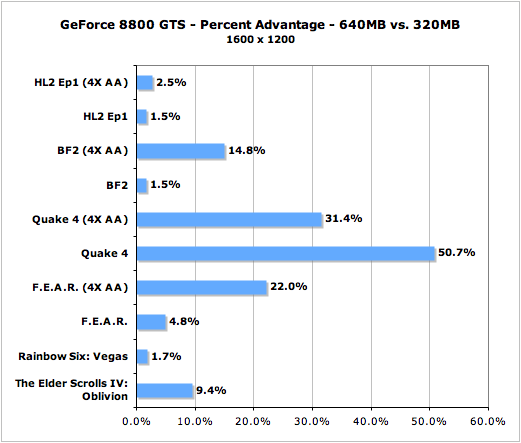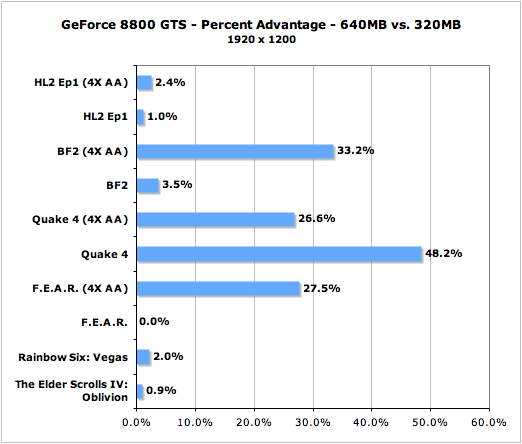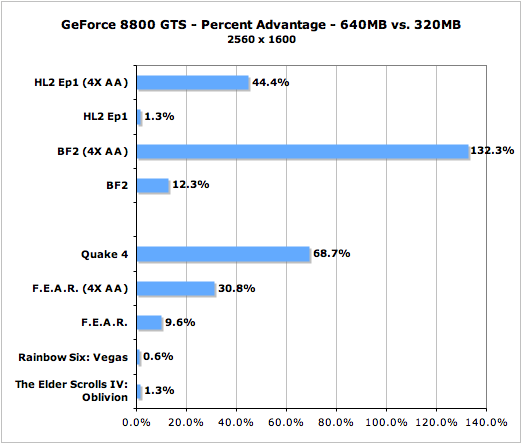Power Within Reach: NVIDIA's GeForce 8800 GTS 320MB
by Derek Wilson on February 12, 2007 9:00 AM EST- Posted in
- GPUs
Does Size Matter?
To answer our question: it depends. Different games seem to be impacted in dramatically different ways, and resolution does play a large role in how much memory size matters. In order to understand the differences, we have taken all our 8800 GTS and 8800 GTS 320MB numbers and looked at how much faster the 640MB part performs via percent increase.
The graphs below are organized by resolution. Unfortunately, the scale between each graph couldn't be kept the same as the variation on the data was much too high. We should also remember that each of our tests can have a bit of variance. We try to keep this to 3%, but that means these numbers could have a little higher deviance. First up is 1600x1200.

Quake 4 jumps out as being a huge beneficiary of more memory. We do test with Ultra Mode, which means uncompressed textures and uncompressed normal maps. This seems to have a huge impact on performance, affording the 640MB card a 50% performance advantage over its new little brother.
In most of the other cases where size matters, the big performance hit comes along with enabling 4xAA. The memory requirement for enabling AA can be quite high, but the exception here is Quake 4. Memory size seems to have less of an impact with AA enabled, but keep in mind that the performance of both cards is much lower with 4xAA enabled.

Looking at 1920x1200, most of the numbers are very similar to what we saw with 1600x1200. This isn't surprising, as the number of pixels being rendered at each of these resolutions is similar. This time around, the odd man out is Battlefield 2. There is a much larger impact on performance under BF2 with 4xAA enabled at 19x12 when running the 320MB 8800 GTS as opposed to the 640MB part.

The trend continues here with BF2 jumping way up in performance difference at 2560x1600. F.E.A.R. and Battlefield 2 both see a larger performance drop at this resolution even with AA disabled. Also of interest is the fact that this resolution shows an impact on Half-Life 2: Episode One with 4xAA whereas others did not.
It is very important to note that Oblivion and Rainbow Six: Vegas don't see much of a performance loss with the decreased memory size. Of course, we can't test these applications with AA enabled, but it is still interesting that there remains so little difference between these numbers. This is especially compelling; as Oblivion and Vegas are the two best looking games in our test suite. Rainbow Six even uses the Unreal Engine 3 from Epic which is capable of producing some incredible visuals.
Does that mean size won't matter in the future or with other UE3 titles? We can't say that with any real certainty, as developers can always find ways to push memory usage. But that does mean that right now, gamers who play a lot of Oblivion and Rainbow Six: Vegas will find a better value in the 8800 GTS 320MB than the 640MB version.
When looking at other titles, especially with AA enabled at high resolutions, the 640MB card does offer much more than the 320MB part. But is it compelling enough to warrant spending an extra $100? Let's take a look at the individual performance numbers and find out.
To answer our question: it depends. Different games seem to be impacted in dramatically different ways, and resolution does play a large role in how much memory size matters. In order to understand the differences, we have taken all our 8800 GTS and 8800 GTS 320MB numbers and looked at how much faster the 640MB part performs via percent increase.
The graphs below are organized by resolution. Unfortunately, the scale between each graph couldn't be kept the same as the variation on the data was much too high. We should also remember that each of our tests can have a bit of variance. We try to keep this to 3%, but that means these numbers could have a little higher deviance. First up is 1600x1200.

Quake 4 jumps out as being a huge beneficiary of more memory. We do test with Ultra Mode, which means uncompressed textures and uncompressed normal maps. This seems to have a huge impact on performance, affording the 640MB card a 50% performance advantage over its new little brother.
In most of the other cases where size matters, the big performance hit comes along with enabling 4xAA. The memory requirement for enabling AA can be quite high, but the exception here is Quake 4. Memory size seems to have less of an impact with AA enabled, but keep in mind that the performance of both cards is much lower with 4xAA enabled.

Looking at 1920x1200, most of the numbers are very similar to what we saw with 1600x1200. This isn't surprising, as the number of pixels being rendered at each of these resolutions is similar. This time around, the odd man out is Battlefield 2. There is a much larger impact on performance under BF2 with 4xAA enabled at 19x12 when running the 320MB 8800 GTS as opposed to the 640MB part.

The trend continues here with BF2 jumping way up in performance difference at 2560x1600. F.E.A.R. and Battlefield 2 both see a larger performance drop at this resolution even with AA disabled. Also of interest is the fact that this resolution shows an impact on Half-Life 2: Episode One with 4xAA whereas others did not.
It is very important to note that Oblivion and Rainbow Six: Vegas don't see much of a performance loss with the decreased memory size. Of course, we can't test these applications with AA enabled, but it is still interesting that there remains so little difference between these numbers. This is especially compelling; as Oblivion and Vegas are the two best looking games in our test suite. Rainbow Six even uses the Unreal Engine 3 from Epic which is capable of producing some incredible visuals.
Does that mean size won't matter in the future or with other UE3 titles? We can't say that with any real certainty, as developers can always find ways to push memory usage. But that does mean that right now, gamers who play a lot of Oblivion and Rainbow Six: Vegas will find a better value in the 8800 GTS 320MB than the 640MB version.
When looking at other titles, especially with AA enabled at high resolutions, the 640MB card does offer much more than the 320MB part. But is it compelling enough to warrant spending an extra $100? Let's take a look at the individual performance numbers and find out.










55 Comments
View All Comments
tacoburrito - Monday, February 12, 2007 - link
With all the eye candy turned on, the 320mb card seems to be only on par with the previous gen 79xx cards, but costs almost twice as much. I'd much rather cough up the extra $200 and get the full GTS version.DerekWilson - Monday, February 12, 2007 - link
Actually, the 320MB card blows away the 7 series in our tests. Why would you say that it's only on par? At 16x12, the 8800 GTS 320MB is 60% faster, and the difference in performance only gets larger from there.tacoburrito - Monday, February 12, 2007 - link
With the exception of Half Life 2, at 4x AA, wouldn't you say that the 8800 GTS 320 is only marginally better than 7950 GT, but would costs twice a much?tacoburrito - Monday, February 12, 2007 - link
Whoops, I meant to say 7900 GTXDerekWilson - Monday, February 12, 2007 - link
From the context of the thread, I assumed you were talking about Oblivion.Without AA, the 8800 320MB is much better than the 7900 GTX. With AA, there is an argument to be made, but the price of the 7900 GTX (as Jarred pointed out) is higher.
JarredWalton - Monday, February 12, 2007 - link
I'd be very curious to find out where you're seeing 7900 GTX cards for "half the price". I don't see any in stock when taking a quick look at major resellers, and our http://labs.anandtech.com/products.php?sfilter=462">Pricing Engine confirms that. I'm pretty sure the 7900 GTX is discontinued now, and prices never got below $400.Wwhat - Monday, February 12, 2007 - link
It still remains to be seen how DX10 games (or future OpenGL games that use geometry shaders?) run on the various incarnations of the new cards, you should have put that in the conclusion as a caveat, it's not just textures anymore you know.I don't thinks there's anything at all currently that uses geometry shaders, you wonder why some developer doesn't throw together a quick test utility, billions of people on the planet and nobody can do that little effort? geez.
Surely someone at crytek or Id or something can write a small looping thing with a framecounter? anand should send out some mails, get someone on his feet.
DerekWilson - Monday, February 12, 2007 - link
There are some dx10 sample apps that make use of geometry shaders ... I've been working on testing these, but it is more difficult than it may seem as FRAPS has trouble with DX10 apps.You do have a point though -- DX10 performance will be important. The problem is that we can't really make a recommendation based on DX10 performance.
The 8 series parts do have more value than the 7 series and x1k series parts in that they support DX10. But this is as far as we can take it. Performance in the games we have does matter, and it is much more prudent to make a purchase only based on the information we know.
Sure, if the cost and performance of an 8 series part is the same or very near some DX9 class hardware, the features and DX10 support are there to recommend it over the competition. But it's hard to really use this information in any other capacity without knowing how good their DX10 support really is.
Awax - Monday, February 12, 2007 - link
The main point for me is the low impact of memory size on modern games.On previous generation game, like Quake4, developers had to use a lot of high resolution texture/bump map/lookup map to achieve advanced effect with the limited capacity in raw performances and flexibility of the cards available.
With DX9 and more in DX10, the new way is to _CALCULATE_ things completely instead of having them interpolated with tricks using intermediary results or already computed lookup tables stored in textures.
DerekWilson - Monday, February 12, 2007 - link
But new ways to calculate things will also benefit from having huge amounts of data to calculate things from.It's really hard to speculate on the direction DX10 games will take at this point. Certianly we will see more use of programmable features and a heavier impact on processing power. But memory usage will also increase. We'll just have to wait and see what happens.